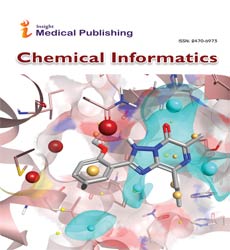Drug Design: The Art and Science of Creating Life-Saving Medicines
Christopher Wells*
Department of Chemistry, University of Fribourg, Fribourg, Switzerland
- *Corresponding Author:
- Christopher Wells
Department of Chemistry,
University of Fribourg, Fribourg,
Switzerland,
E-mail: wells_c@gmail.com
Received date: February 11, 2023, Manuscript No. IPCHI-23-16802; Editor assigned date: February 13, 2023, PreQC No. IPCHI-23-16802 (PQ); Reviewed date: February 24, 2023, QC No. IPCHI-23-16802; Revised date: March 04, 2023, Manuscript No. IPCHI-23-16802 (R); Published date: March 11, 2023, DOI: 10.36648/2470-6973.9.01.134
Citation: Wells C (2023) Drug Design: The Art and Science of Creating Life-Saving Medicines. Chem inform Vol.9.No.01:134
Description
Drug design is an intricate and multidisciplinary field that involves the creation and development of new therapeutic molecules to combat diseases and improve human health. It combines elements of chemistry, biology, pharmacology, and computational modelling to design molecules that interact with specific biological targets, such as proteins or enzymes, and modulate their function. In this article, we will delve into the fascinating world of drug design, exploring its principles, strategies, and impact on modern medicine.
Structural Biology and Drug Design
The first step in drug design is to identify a specific target within the body that is involved in the disease process. This target could be a protein, an enzyme, a receptor, or any other biomolecule that plays a crucial role in the pathological condition. Understanding the structure and function of the target is essential to design molecules that can interact with it and modulate its activity. Advancements in structural biology techniques, such as X-ray crystallography and cryo-electron microscopy, have revolutionized the field of drug design. These techniques enable scientists to determine the three-dimensional structure of biomolecules, providing valuable insights into their shape, active sites, and binding pockets. This information is vital for designing molecules that can bind to the target with high affinity and specificity.
Rational drug design, also known as structure-based drug design, is a strategy that utilizes the knowledge of the target's structure to design molecules that fit precisely into its active site. This approach involves computational modelling techniques, such as molecular docking and molecular dynamics simulations, to predict the binding interactions between the target and potential drug candidates. In rational drug design, scientists analyse the target's structure and identify key regions or residues that are essential for its function. Based on this information, they design small molecules or chemical fragments that can bind to these critical sites and disrupt or modulate the target's activity. Through an iterative process of computational modelling, synthesis, and biological testing, scientists optimize the molecules to enhance their potency, selectivity, and pharmacokinetic properties. High-throughput screening (HTS) is another strategy used in drug design, particularly for identifying lead compounds from large libraries of small molecules. HTS involves testing thousands or even millions of compounds against a specific target in a rapid and automated manner. The goal is to identify molecules that show promising activity or binding affinity to the target, which can then serve as starting points for further optimization.
To facilitate the drug design process, researchers have access to extensive chemical libraries that contain a vast collection of small molecules with diverse structures. These libraries can be synthesized in-house or obtained from commercial sources. By screening these libraries or utilizing virtual screening methods, scientists can identify lead compounds with desired properties. Once lead compounds are identified, medicinal chemists employ various strategies to optimize their properties. This involves modifying the chemical structure of the lead molecule to improve its potency, selectivity, metabolic stability, and other pharmacokinetic properties. Through structure-activity relationship (SAR) analysis, scientists investigate the relationship between the chemical structure of the lead compound and its biological activity, making iterative changes to enhance its efficacy and reduce potential side effects.
In some cases, the inherent properties of a drug molecule, such as poor solubility or rapid metabolism, can limit its efficacy or bioavailability. To overcome these challenges, pro-drugs and drug delivery systems are employed in drug design. Pro-drugs are inactive or less active forms of a drug that undergo specific chemical transformations in the body to release the active drug at the target site. Drug delivery systems, such as nanoparticles or liposomes, are designed to encapsulate and deliver drugs to specific tissues or cells, enhancing their therapeutic effects and minimizing side effects.
Clinical Trials and Regulatory Approval
Once a promising drug candidate has been identified through the drug design process, it undergoes rigorous testing in preclinical and clinical trials. Preclinical studies assess the compound's safety, efficacy, and pharmacokinetic profile in animal models, while clinical trials involve testing the drug in human subjects to evaluate its effectiveness, dosage, and potential adverse effects. The data from these trials are submitted to regulatory authorities, such as the U.S. Food and Drug Administration (FDA) or the European Medicines Agency (EMA), for review and approval. The regulatory approval process ensures that the drug is safe, effective, and of high quality before it can be marketed and prescribed to patients.
Drug design is a complex and dynamic field that combines scientific knowledge, innovative technologies, and computational modelling to create life-saving medications. Through a combination of rational drug design, high-throughput screening, and optimization strategies, scientists are continually advancing the development of new drugs and improving existing therapies. The impact of drug design on modern medicine cannot be overstated, as it has revolutionized the treatment of numerous diseases and has the potential to transform healthcare in the future.
Open Access Journals
- Aquaculture & Veterinary Science
- Chemistry & Chemical Sciences
- Clinical Sciences
- Engineering
- General Science
- Genetics & Molecular Biology
- Health Care & Nursing
- Immunology & Microbiology
- Materials Science
- Mathematics & Physics
- Medical Sciences
- Neurology & Psychiatry
- Oncology & Cancer Science
- Pharmaceutical Sciences
